
Drilling is a process that enables holes of different sizes to be made in solid materials, using specific cutting and drilling tools.
Depending on the machinery and the tool used, it is possible to obtain very small circular holes (from 1 mm in diameter), to holes of up to a few centimetres in diameter.
The characteristics of the router bit used to drill the wood have a major effect on the quality and precision of the holes obtained, especially given that during the drilling process, a number of different variables influence the final result.
As such, focusing on the quality of the tools used for drilling is essential in order to achieve satisfactory results, especially in machining operations where high levels of precision and finish quality are required when drilling the holes.
In the wood and furniture industry, wood drilling is a routine machining operation, performed for multiple purposes. Holes, slots and seats are created in order to insert hinges and locks, or for shelving: in the furniture industry, this is a core machining operation which requires the highest possible levels of precision, in order to ensure that the various components of a piece of furniture fit together perfectly.
For this reason, these operations call for the use of machinery of the very best quality, along with drilling tools that are suitable for the type of hole that needs to be made; in addition, experienced and qualified personnel who know how to use these machines and tools to their full potential are a must.
In the rest of this article, we will attempt to gain a better understanding of the process of drilling wood in terms of the machine operations carried out, and will find out how far the "tools of the trade" affect the final result, as well as looking at the characteristics of drilling tools that can make a real difference.
- Wood drilling machines: the most widely used at industrial level
- There are holes, and then there are holes: types and functions
- Wood drilling tools: how to choose the right one
- Wood drilling: when the tool makes all the difference
- Each hole has its own boring bit: materials and characteristics
- Choosing tools for drilling wood: the importance of asking the experts
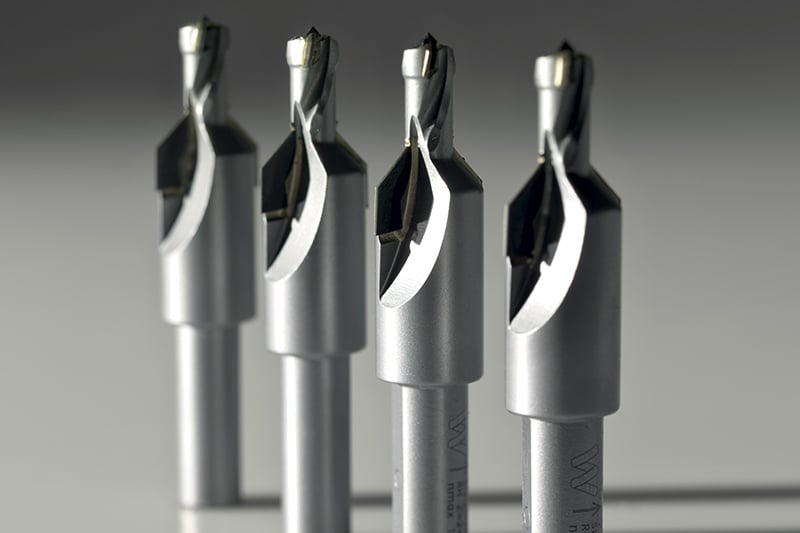
Wood drilling machines: the most widely used at industrial level
There are various types of machines for wood drilling on the market.
The choice of one type or another primarily depends on the size of the company. Indeed, running a small woodworking company is quite different to managing the intense production requirements of medium-large industrial organisations that work with wood.
When selecting the desired characteristics of the wood drilling machinery to be used, it is essential to take into account the type of machining operation to be carried out first and foremost.
Let's take a look at the main types of drilling machines used at industrial level.
- Automatic drilling machines: thanks to the high level of automation, this type of drilling machine is widely used in the production of furniture, as it can produce a large number of pieces per minute with high levels of precision and excellent finish quality; in addition, the latest generation machines use increasingly sophisticated technologies, enabling rapid programme changes, which significantly reduces machine downtime.
- Numerical control drilling machines: these machines are very common in the woodworking industry due to the fact that they enable hundreds of drilling operations to be carried out in real time without interruption, guaranteeing high levels of flexibility (machining of panels of different sizes and thicknesses) and maximum precision without splintering, courtesy of the numerical control functionality.
- Semi-automatic drilling machines: these machines are also perfect for artisan producers and small medium-sized companies, as they combine excellent technical performance with the flexibility and versatility normally required by companies that do not work “in series”, like on a production line, but which instead use a diverse range of drilling operations.
While it is true that the automation and technology of the latest generation drilling machines can guarantee excellent results and maximum precision in wood drilling, it is also accurate to say that the final quality of the drilling operation is also determined by the type and quality of the boring bits used.
The theme of drilling tools,which we will look into in more depth shortly, is closely connected to the boring process itself, which enables different types of hole to be made.
There are holes, and then there are holes: types and functions
The shape, size and type of hole can vary enormously, and this is primarily due to the physical-mechanical characteristics of the wood, which is a "living" material with high workability.
But how many types of holes are there? Let's find out!
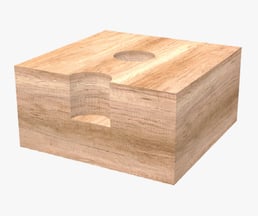
Blind hole
Cylindrical in shape, a blind hole does not completely traverse the material from side to side: rather, it is a hole that only partially punctures the panel, and is only visible from one side. The dimensions of these holes vary in accordance with the thickness of the panel and the purpose for which it is to be used.
Generally, this type of machining operation is necessary in order to fix the doors of a piece of furniture in place,to create a slot for plugs or dowels for assembling shelves or in the assembly of various components of a single structure, such as a wardrobe.
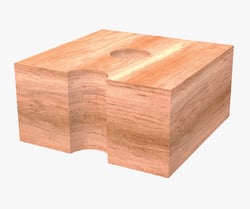
Through hole
As the name suggests, this type of cylindrical hole passes through the panel from one side to the other. It is carried out primarily for functional reasons - for example, to create a space in a panel through which to insert electrical cables or a component of the furniture - but in some cases, a through hole may simply serve an aesthetic purpose.

Countersink holes
In the case of a countersink, at the mouth of the hole there is a small conical section, which can be either blind or through; the function of this is to allow the insertion of a screw or countersunk bolt so that the screw or bolt head is flush with the surface of the panel.
Some types of hole are made specifically to accommodate hinges, others have sloping walls (conical hole), and some types feature part of the hole with a larger diameter at the mouth, for the seating of a bolt head.
Tools for wood drilling: how to choose the right one
How does one choose the most suitable boring bit to make the desired type of hole?
First of all, we must remember that wood is a "soft", workable material. This property facilitates the drilling process, rendering it faster than that required for machining hard materials such as metal. However, this does not mean that drilling wood is an easy, straightforward process, or that specific technical knowledge is not required.
In fact, exactly the opposite is true: with wood, more care must be taken when making the hole, as the risk of "burning" the panel is higher than with harder and more compact materials.
One of the major critical issues that arises when drilling wood is linked to the ability to create clean entry and exit holes with an excellent finish, without damaging the delicate wood fibres.
The stability and durability of a piece of furniture is dependent on the precision with which the holes are made. And conversely, even the slightest inaccuracy can be detrimental to the end result.
Is the importance of the wood drilling tools now clearer?
Wood drilling: when the tool makes all the difference
As we saw previously, latest-generation wood drilling machines offer high performance and are capable of creating a large number of holes with great precision, but the finish quality is largely dependent on the tool that is used.
Everything can make a difference (for better or for worse) when it comes to drilling wood: from speed parameter settings to the choice of boring bits with geometries and teeth suitable for the machining operation to be carried out - and not forgetting the skill and precision of the operator.
And because we are talking about processes in which precision is of the utmost importance, the choice of wood drilling tools cannot be taken lightly, or without being aware of all the factors at stake.
This is why it is essential to seek guidance from manufacturers with proven experience, who know how to direct users towards the boring bits with the ideal shape and size for the machining operation to be carried out, taking into account the desired level of precision and the type of wood to be machined.
Nothing can be overlooked or left to chance. Each of the various parameters must be carefully analysed, and we must ask ourselves: which part of the panel is involved in the machining operation? How deep does the hole need to be? What degree of finish is required?
Only by looking at all the answers to these questions together is it possible to identify the shape, material and geometry of the most suitable cutting edges for the boring bits required.
Each hole has its own boring bit: materials and characteristics
The first classification is also the most intuitive: each type of hole has its own dedicated boring bit.
As such, we have:
- Boring bits for blind holes
- Boring bits for through holes
- Boring bits for hinges
- Boring bits with countersink for creating blind and through holes
And the material?
Each of the boring bit types indicated can be made with cutting edges in polycrystalline diamond (PCD), tungsten carbide (HW) or solid tungsten carbide (HWM).
Let's take a look at the differences between the materials in terms of their characteristics, performance and uses.
Boring bits in polycrystalline diamond (PCD)
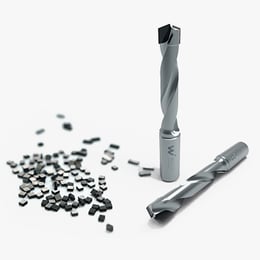
The compactness and extraordinary resistance to wear of PCD boring bits enable them to be effectively used for drilling operations on abrasive composite materials that are difficult to machine with tungsten carbide, and for repeated drilling operations on chipboard, laminates, MDF, coated MDF and melamine materials. Generally, the body of these drilling tools is made from tungsten carbide (HW) or solid tungsten carbide (HWM).
Polycrystalline diamond boring bits also guarantee low friction and a longer cutting life than other types.
Precisely because of the quality of the hole that they can achieve, PCD tips are more expensive than solid tungsten carbide versions, although the initial difference in investment is negated very quickly due to the excellent technical performance and greater speed of execution offered by these tools, which enables increased production, optimised performance and reduced processing costs.
Boring bits in tungsten carbide (HW) or solid tungsten carbide (HWM)
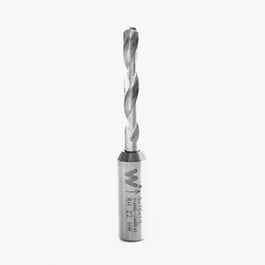
Boring bits made from HW or HWM are suitable for the machining of laminated materials, solid woods and derivatives thereof.
Indeed, tungsten carbide combines high wear resistance with resistance to splitting.
Due to their hardwearing nature, HW boring bits are mainly used for machining hardwoods that require greater chip discharge.
They are also suitable for "versatile" machining operations - in which the type of material processed in a single given day varies frequently - due to the fact that they produce very sharp, clean cutting results and good quality finishes.
In addition, the ability to withstand high temperatures makes tungsten carbide drilling tools perfect for safely performing repeated operations with most drilling machinery.
Choosing tools for wood drilling: the importance of asking the experts
In this article, we have looked at the extent to which the choice of boring bits affects the final result of a wooden product: a slight inaccuracy in the drilling of a hole can be enough to compromise the stability and durability of a piece of furniture.
It is true that in the industrial field, the machines used for drilling wood are so innovative and highly automated that they minimise the risk of errors, but the human component (i.e. the precision of the operator) and the use of the right drilling tool are nonetheless elements that make a real difference.
For this reason, when choosing the boring bit and the tool for making the various types of hole that may be required, it is essential to turn to experienced and competent suppliers for advice, such as Wirutex; for more than 40 years the company has been producing a wide range of drilling tools, with cutting edges in polycrystalline diamond, tungsten carbide and solid tungsten carbide, to be used on drilling machines and on CNC machining centres.
The only way to ensure reliable results and guarantee precise machining operations of impeccable quality is to work with companies that are capable of analysing each of the aspects involved in machining, before selecting the most suitable type of tip.
We know, for example, that not all woods are the same. Assessing the consistency of the wood – hard, soft, composite, pure, lamellar, stratified – enables the boring bit with the most appropriate geometry and size to be chosen. Some woods, such as chipboard, may contain scrap metal: it is important to be aware that diamond boring bits are not compatible with ferrous materials and that as such, tungsten carbide or solid tungsten carbide drilling tools must be used in these cases.
These are just a few examples of how important it is to place one’s trust in competent suppliers when choosing the right tools for drilling wood, and to avoid making rushed or ill-informed decisions at all costs.
All that remains is to visit the section dedicated to boring bits produced by Wirutex and follow the advice of the experts!
v



